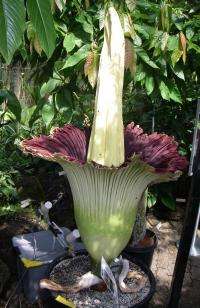If plants generate magnetic fields, they're not sayin'

Searching for magnetic fields produced by plants may sound as wacky as trying to prove the existence of telekinesis or extrasensory perception, but physicists at the University of California, Berkeley, are seriously looking for biomagnetism in plants using some of the most sensitive magnetic detectors available.
In an article that appeared this week in the Journal of Applied Physics, ('Search for plant biomagnetism with a sensitive atomic magnetometer', J. Appl. Phys. 109, 074701), the UC Berkeley scientists describe the instruments they used to look for minuscule magnetic fields around a titan arum – the world's largest flower – during its brief bloom, the interference from local BART trains and traffic that bedeviled the experiment, and their ultimate failure to detect a magnetic field.
They established, however, that the plant generated no magnetic field greater than a millionth the strength of the magnetic field surrounding us here on Earth.
Why look for biomagnetism in plants?
"There is a lot of activity now by scientists studying biomagnetism in animals, but not in plants," said Dmitry Budker, UC Berkeley professor of physics. "It is an obvious gap in science right now."
In animals, for example, activity in the heart and brain produce tiny magnetic fields that can be measured by sensitive magnetometers.
"We feel like this is a first step in an interesting direction that we would like to pursue," he added.
Budker spends most of his time developing extremely sensitive magnetic field detectors – in particular, atomic magnetometers based on nonlinear magnetooptical rotation (NMOR). These devices can measure magnetic fields as low as 10 femtotesla, nearly a billion times lower than Earth's magnetic field at the surface, which is usually between 20 and 50 microtesla, depending on the location.
Magnetic noise in the laboratory initially led the Budker team to the University of California Botanical Garden, which provided an isolated space for them to test their magnetometers. There, the researchers, including graduate student Eric Corsini, encountered the garden's famed titan arum (Amorphophallus titanium), a plant that every few years sends up a tall, thick stalk covered with thousands of small flowers enveloped by one large, flower-like calyx. During its brief flowering, the plant gives off a powerful odor of rotting flesh to attract the carrion beetles and flesh flies that pollinate it.
"This giant, skirt-like thing opens fairly quickly, over an hour or two, and the plant starts to heat up and get really warm, and then gives off this odor that is strongest for the first 12 hours," said Paul Licht, director of the UC Botanical Garden. "By the end of 24 hours, all the real action is over; the pollination cycle has a very brief window to succeed."
Because magnetic fields are created by moving electrical charges, such as a current of electrons, the researchers thought that rapid processes in the plant during the rapid heating might involve flowing ions that would create a magnetic field. In the titan arum, the rapid heating raises the plant temperature as high as 20 to 30 Celsius (70-85 degrees Fahrenheit).
"In principle, there shouldn't be a fundamental difference between animals and plants in this respect, but as for which plants might produce the highest magnetic fields, that is a question for biologists," Budker said.
In June 2009, one of the garden's arums was ready to erupt, so the Budker group, headed by Corsini, set up a sensitive, commercial magnetometer next to the plant in a hothouse and monitored it continually. During the day, visitors entering the hothouse generated magnetic signals, and the BART trains several miles away created .05 microtesla signals periodically.
"We were most disappointed in not being able to put a tighter tolerance on our measurement, because we couldn't find a way to cancel out the local ambient magnetic field noise," Corsini said.
He and Budker expect that they can increase their sensitivity by a factor of 10 or 100, however.
"We haven't given up," Corsini said. "The next step is to see whether we can get hold of a smaller plant and perhaps shield it from outside magnetic fields far from public viewing. So far, biomagnetism is a fun side project for me, but if we were to see something …."
"The hope is that, next time one flowers, we're going to get it," Licht said.
People who want their own titan arum can purchase offspring, some now three to four feet high, at the botanical garden. While these plants make fascinating and easy houseplants, however, the owner should be prepared to move out of the house for a night when the plant ultimately flowers, Licht said.
More information: Search for plant biomagnetism with a sensitive atomic magnetometer, J. Appl. Phys. 109, 074701 (2011); doi:10.1063/1.3560920
Provided by University of California - Berkeley





















